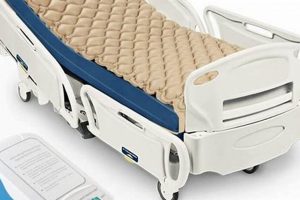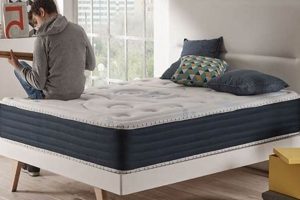A supplementary layer designed to enhance the comfort and support of a mattress, particularly beneficial for individuals experiencing discomfort in the lumbar region. Such products aim to alleviate pressure points, improve spinal alignment, and promote a more restful sleep. For example, a memory foam variant can conform to the body’s contours, distributing weight evenly and reducing stress on the lower back.
The selection of appropriate bedding accessories can significantly impact sleep quality and musculoskeletal health. Historically, individuals have sought methods to modify their sleeping surfaces to address back-related issues. Implementing an overlay can offer a cost-effective alternative to replacing an entire mattress, providing customized support and potentially reducing pain and stiffness. Moreover, optimized sleep positioning facilitated by these items contributes to overall well-being.
Understanding the properties of various materials, such as memory foam, latex, and down alternatives, is crucial when selecting an overlay. Assessing individual sleep preferences, including preferred sleeping position and firmness level, is paramount to achieving optimal comfort and support. Further consideration should be given to factors such as thickness, density, and potential allergens to ensure a suitable choice.
Tips for Selecting a Mattress Topper to Mitigate Lumbar Discomfort
The following recommendations provide guidance on choosing a suitable overlay to address lower back pain, emphasizing factors that contribute to improved sleep posture and pressure relief.
Tip 1: Prioritize Material Density. A denser material, such as high-density memory foam or latex, provides increased support and is less likely to compress excessively under pressure, maintaining spinal alignment.
Tip 2: Consider Thickness. A minimum thickness of three inches is generally recommended for significant pressure relief. Individuals with pronounced lower back pain may benefit from even thicker options.
Tip 3: Evaluate Firmness Level. The optimal firmness depends on individual sleeping position and body weight. Side sleepers typically benefit from softer options, while back and stomach sleepers may require firmer support.
Tip 4: Investigate Temperature Regulation. Materials like gel-infused memory foam or latex offer enhanced breathability, preventing overheating and promoting a more comfortable sleep environment.
Tip 5: Ensure Proper Fit. The chosen overlay should match the dimensions of the existing mattress to prevent shifting or overhang, which can compromise support.
Tip 6: Assess Pressure Relief Capabilities. Look for products specifically designed to alleviate pressure points in the lumbar region, such as those with zoned construction or targeted support.
Tip 7: Explore Certifications. Certifications like CertiPUR-US indicate that the foam has been tested for harmful substances and emissions, ensuring a healthier sleep environment.
Implementing these strategies can lead to a more comfortable sleep experience, potentially reducing lumbar discomfort and promoting improved spinal health.
Careful consideration of these factors is essential for selecting an appropriate item that effectively addresses individual needs and preferences. Subsequent sections will delve into specific material properties and their respective benefits.
1. Material Density
Material density plays a critical role in determining the efficacy of a mattress topper for individuals experiencing lumbar discomfort. It directly influences the level of support provided and the topper’s ability to maintain spinal alignment throughout the night, thus affecting the potential for pain reduction and improved sleep quality.
- Support and Longevity
Higher density materials, such as high-density memory foam or latex, offer superior support compared to less dense alternatives. They resist compression over time, preventing the topper from flattening or losing its shape, thereby ensuring consistent support and extending its lifespan. A denser topper is better equipped to support the body’s weight and maintain proper spinal alignment, reducing strain on the lower back.
- Pressure Distribution
Density influences the topper’s ability to distribute weight evenly, minimizing pressure points that can exacerbate lower back pain. Denser materials conform to the body’s contours, providing targeted support to areas that need it most, while dispersing pressure across a wider surface area. This reduces localized stress on the lumbar region, promoting relaxation and reducing discomfort.
- Impact on Spinal Alignment
Maintaining proper spinal alignment is crucial for alleviating low back pain. High-density toppers contribute to this by preventing excessive sinking or sagging, which can misalign the spine and lead to increased strain. By providing a stable and supportive surface, denser materials help maintain the natural curvature of the spine, promoting a more comfortable and restful sleep experience.
- Heat Retention Properties
While not directly related to support, density can affect heat retention. Denser materials tend to trap more heat than less dense alternatives. Consequently, individuals prone to overheating during sleep should consider toppers with open-cell structures or cooling technologies, even if the density is desirable for support purposes. Balancing density with breathability is essential for optimal comfort.
In conclusion, material density is a primary determinant of the supportive qualities of a mattress topper. The selection of a higher-density option is generally advisable for those seeking relief from low back pain, but careful consideration of factors such as heat retention and breathability is also necessary to ensure a comfortable and effective sleep solution. The appropriate density will provide the foundation for spinal alignment and pressure relief, which are paramount for mitigating lumbar discomfort.
2. Thickness
The thickness of a mattress topper is a critical determinant of its ability to alleviate lumbar discomfort. Insufficient thickness may fail to provide adequate cushioning and support, while excessive thickness can lead to instability or improper spinal alignment. Therefore, the selection of an appropriate thickness is paramount when choosing a mattress topper designed to mitigate lower back pain.
An overlay with inadequate depth may not effectively distribute pressure points, resulting in continued strain on the lumbar region. For instance, a thin memory foam topper might compress entirely under the weight of the hips, offering minimal relief. Conversely, an excessively thick topper could alter the sleeping surface’s profile to such an ext
ent that it negatively impacts spinal alignment, potentially exacerbating existing back issues. Consider the example of a stomach sleeper who uses a very thick topper; the resulting upward curvature of the spine can intensify lower back pain. The ideal thickness balances pressure relief with postural support.
The optimal thickness is contingent upon factors such as body weight, sleeping position, and the firmness of the underlying mattress. Generally, a thickness of at least three inches is recommended for individuals seeking significant pressure relief. This measurement provides sufficient material to conform to the body’s contours, distribute weight evenly, and maintain spinal alignment. Thicker options, ranging from four to six inches, may be considered for individuals with higher body mass or those who prefer a plusher sleeping surface. Careful evaluation of these factors is essential for selecting a topper thickness that effectively addresses individual needs and promotes lumbar support. Ultimately, the appropriate thickness contributes to a reduction in pain and an improvement in sleep quality.
3. Firmness
The selection of a mattress topper with appropriate firmness significantly impacts individuals experiencing lumbar discomfort. Firmness, in this context, refers to the degree of resistance offered by the topper to compression. An unsuitable firmness level can exacerbate existing back pain, while an appropriately chosen firmness level can alleviate pressure points and promote proper spinal alignment.
An overly soft mattress topper may not provide sufficient support, allowing the spine to sink into an unnatural curvature. This lack of support can strain the lower back muscles and ligaments, leading to increased pain and discomfort. Conversely, a topper that is too firm may not conform to the body’s contours, resulting in pressure points and restricted blood flow. A real-world example might include an individual with scoliosis finding that a medium-firm topper better accommodates the spinal curvature, distributing pressure and minimizing discomfort, compared to a firm topper that creates pressure concentrations. The practical significance lies in the enhanced sleep quality and reduced pain that an appropriate firmness level can offer.
Selecting the correct firmness is, therefore, a highly individualized process. Body weight, sleeping position, and personal preferences all contribute to the optimal firmness level. Side sleepers, for instance, generally benefit from a softer topper that allows the shoulders and hips to sink in slightly, maintaining spinal alignment. Back sleepers may prefer a medium-firm option that provides support without excessive pressure. Stomach sleepers often require a firmer topper to prevent excessive sinking of the abdomen, which can hyperextend the lower back. Accurately assessing these variables presents a challenge, but understanding the impact of firmness is crucial for achieving a comfortable and supportive sleep surface and minimizing lumbar pain.
4. Pressure Relief
Pressure relief is a foundational element in determining the efficacy of a mattress topper for alleviating lower back pain. Its role centers on minimizing concentrated stress on specific areas of the body, thereby promoting circulation and reducing discomfort. The effectiveness of a topper in providing pressure relief directly correlates with its capacity to facilitate restorative sleep and manage lumbar pain.
- Conformity to Body Contours
A topper’s ability to conform to the individual’s unique body shape is paramount for effective pressure relief. Materials such as memory foam excel in this regard, molding to the body’s curves and distributing weight evenly. An example includes a side sleeper whose hips and shoulders exert significant pressure on the mattress; a conforming topper reduces these localized stress points, promoting spinal alignment and mitigating discomfort. Improper conformity can lead to persistent pressure, exacerbating lower back pain.
- Weight Distribution
The manner in which a topper distributes weight across its surface is crucial for pressure relief. Effective weight distribution prevents localized pressure buildup, particularly in areas such as the lumbar region. A topper employing zoned construction, for example, may offer varying levels of support to different areas of the body, ensuring optimal weight distribution and targeted pressure relief where it is most needed. Uneven weight distribution can contribute to pressure points and intensify lower back pain.
- Material Properties and Responsiveness
The inherent properties of the topper’s material significantly influence its pressure relief capabilities. Materials like latex offer a responsive support that adapts to movement and redistributes pressure dynamically, while others, such as gel-infused memory foam, combine conformity with temperature regulation to enhance comfort and minimize pressure buildup. The responsiveness of the material impacts its ability to adapt to changes in sleeping position and maintain consistent pressure relief. Inadequate responsiveness can lead to pressure points and reduced comfort.
- Impact on Circulation
Effective pressure relief promotes healthy circulation by reducing compression on blood vessels. Restricted blood flow can contribute to muscle stiffness and pain. A topper that adequately distributes weight and conforms to the body’s contours minimizes pressure on these vessels, facilitating optimal circulation and promoting muscle relaxation. Improved circulation can contribute to a reduction in lower back pain and an overall improvement in sleep quality.
The interrelationship between these facets underscores the importance of pressure relief in selecting an optimal mattress topper for lower back pain. A topper that effectively conforms to body contours, distributes weight evenly, exhibits responsive material properties, and promotes circulation will contribute significantly to reducing lumbar discomfort and enhancing sleep quality. Failing to address these aspects can diminish the potential benefits of the overlay.
5. Spinal Alignment
The selection of a mattress overlay to mitigate lower back pain is intrinsically linked to its capacity to promote and maintain proper spinal alignment. Misalignment during sleep is a significant contributor to lumbar discomfort, exacerbating existing conditions or inducing new pain. Therefore, the ability of an overlay to support the natural curvature of the spine is a primary determinant of its suitability for individuals seeking relief from back pain.
Achieving optimal spinal alignment necessitates a sleeping surface that adequately supports the body’s weight and conforms to its contours. A topper that is either too firm or too soft can disrupt this alignment. For instance, an overly firm surface may prevent the spine from settling into its natural position, creating pressure points and muscle strain. Conversely, a surface that is too soft may allow the spine to sag, leading to hyperextension of the lower back. The optimal choice varies depending on the individual’s sleeping position. Side sleepers typically benefit from a topper that allows the
shoulders and hips to sink in slightly, maintaining a straight spinal column. Back sleepers often require a more supportive surface to prevent the hips from sinking too deeply. Stomach sleepers generally need a firmer surface to avoid excessive curvature of the spine. The practical result of proper spinal alignment is reduced stress on the intervertebral discs, muscles, and ligaments, leading to a decrease in pain and stiffness.
In summary, the core purpose of a mattress overlay designed to address lower back pain is to facilitate proper spinal alignment. This requires careful consideration of firmness, material properties, and individual sleeping habits. The challenge lies in finding a product that effectively balances support and comfort, adapting to the unique needs of each user. Prioritizing spinal alignment in the selection process is essential for achieving a more restful and pain-free sleep experience.
Frequently Asked Questions
The following section addresses common inquiries regarding the selection and utilization of mattress overlays designed to alleviate lower back discomfort. The objective is to provide clear and informative answers to facilitate informed decision-making.
Question 1: What materials are most conducive to mitigating low back pain?
Memory foam and latex are frequently recommended. Memory foam conforms to the body, distributing weight and alleviating pressure points. Latex offers responsive support and can be more durable.
Question 2: How does the thickness of a mattress topper influence its effectiveness?
Thickness affects the degree of cushioning and support. A minimum of three inches is generally recommended for significant pressure relief. Individuals with higher body weight may benefit from thicker options.
Question 3: Does mattress topper firmness play a role in pain reduction?
Firmness is a critical consideration. The appropriate firmness level depends on individual sleeping position and body weight. Side sleepers often prefer softer options, while back and stomach sleepers may require firmer support.
Question 4: Can a mattress topper correct a sagging mattress?
While a topper can provide temporary relief, it is not a substitute for a supportive mattress. A severely sagging mattress will continue to compromise spinal alignment, regardless of the overlay.
Question 5: How often should a mattress topper be replaced?
The lifespan of a mattress topper varies depending on the material and usage. However, most toppers should be replaced every three to five years to ensure optimal support and hygiene.
Question 6: Are there any potential drawbacks to using a mattress topper?
Some individuals may experience increased heat retention with certain materials, such as memory foam. Additionally, an improperly chosen topper can exacerbate existing back problems if it does not provide adequate support.
Careful consideration of these factors, combined with an understanding of individual needs and preferences, is essential for selecting an appropriate mattress overlay to effectively address lower back pain.
Subsequent sections will provide guidance on proper maintenance and care to maximize the lifespan and effectiveness of chosen products.
Concluding Remarks on Selecting the Optimal Mattress Overlay for Lumbar Alleviation
The preceding exploration of “best mattress topper for low back pain” underscores the intricate interplay of material density, thickness, firmness, pressure relief capabilities, and spinal alignment. The selection process necessitates a comprehensive understanding of individual needs and preferences, coupled with a discerning evaluation of product specifications. Achieving meaningful lumbar support requires a strategic integration of these factors, rather than a reliance on generalized recommendations.
Ultimately, the decision to invest in a mattress topper represents a commitment to musculoskeletal health and enhanced sleep quality. A carefully considered selection, guided by the principles outlined herein, holds the potential to significantly mitigate lower back discomfort and foster a more restorative sleep experience. Ongoing assessment of individual comfort and support requirements remains paramount, ensuring the continued efficacy of the chosen overlay in promoting spinal well-being.


![Find The Best Cheap Amazon Mattress [Deals!] Organic & Natural Mattress Buyer’s Guide: Non-Toxic Sleep Solutions Find The Best Cheap Amazon Mattress [Deals!] | Organic & Natural Mattress Buyer’s Guide: Non-Toxic Sleep Solutions](https://mattressworldpa.com/wp-content/uploads/2025/07/th-7648-300x200.jpg)
![Top Picks: Best Sheets for Your Purple Mattress [Guide] Organic & Natural Mattress Buyer’s Guide: Non-Toxic Sleep Solutions Top Picks: Best Sheets for Your Purple Mattress [Guide] | Organic & Natural Mattress Buyer’s Guide: Non-Toxic Sleep Solutions](https://mattressworldpa.com/wp-content/uploads/2025/07/th-7647-300x200.jpg)

![Top Serta: Best Serta Mattress for Bad Back Relief [Guide] Organic & Natural Mattress Buyer’s Guide: Non-Toxic Sleep Solutions Top Serta: Best Serta Mattress for Bad Back Relief [Guide] | Organic & Natural Mattress Buyer’s Guide: Non-Toxic Sleep Solutions](https://mattressworldpa.com/wp-content/uploads/2025/07/th-7645-300x200.jpg)

